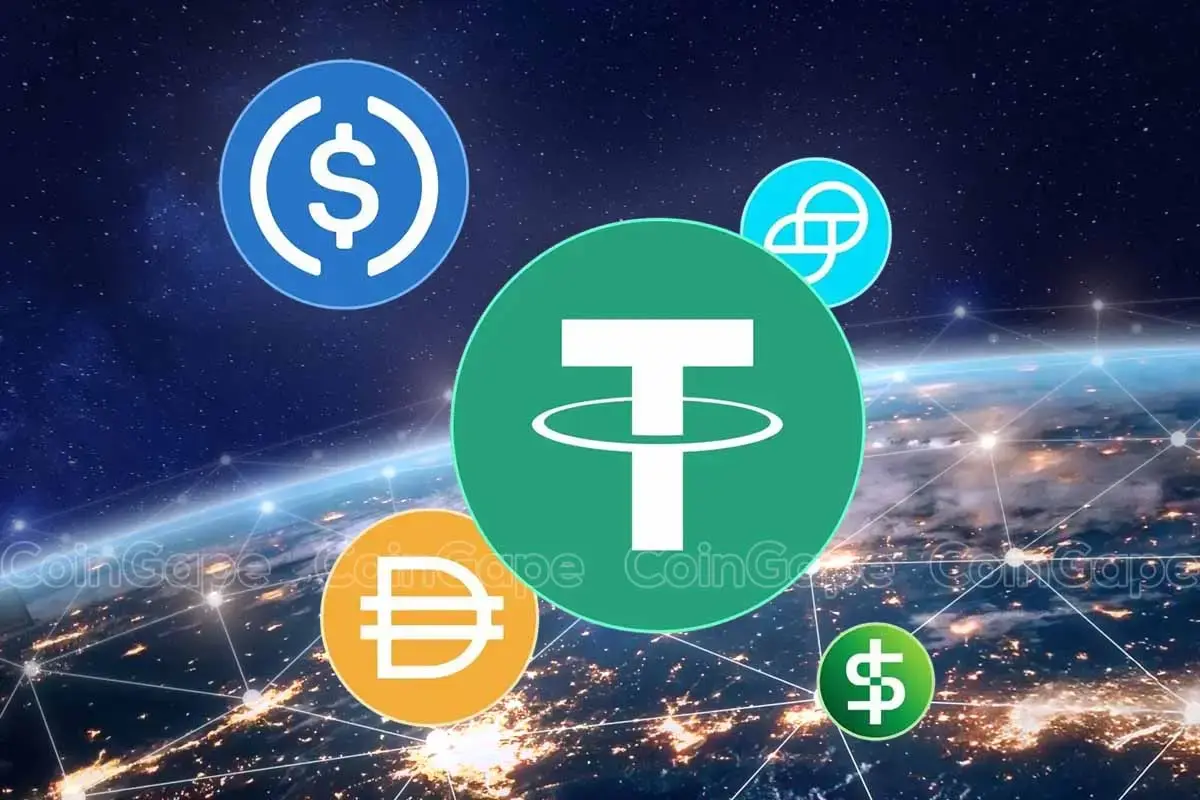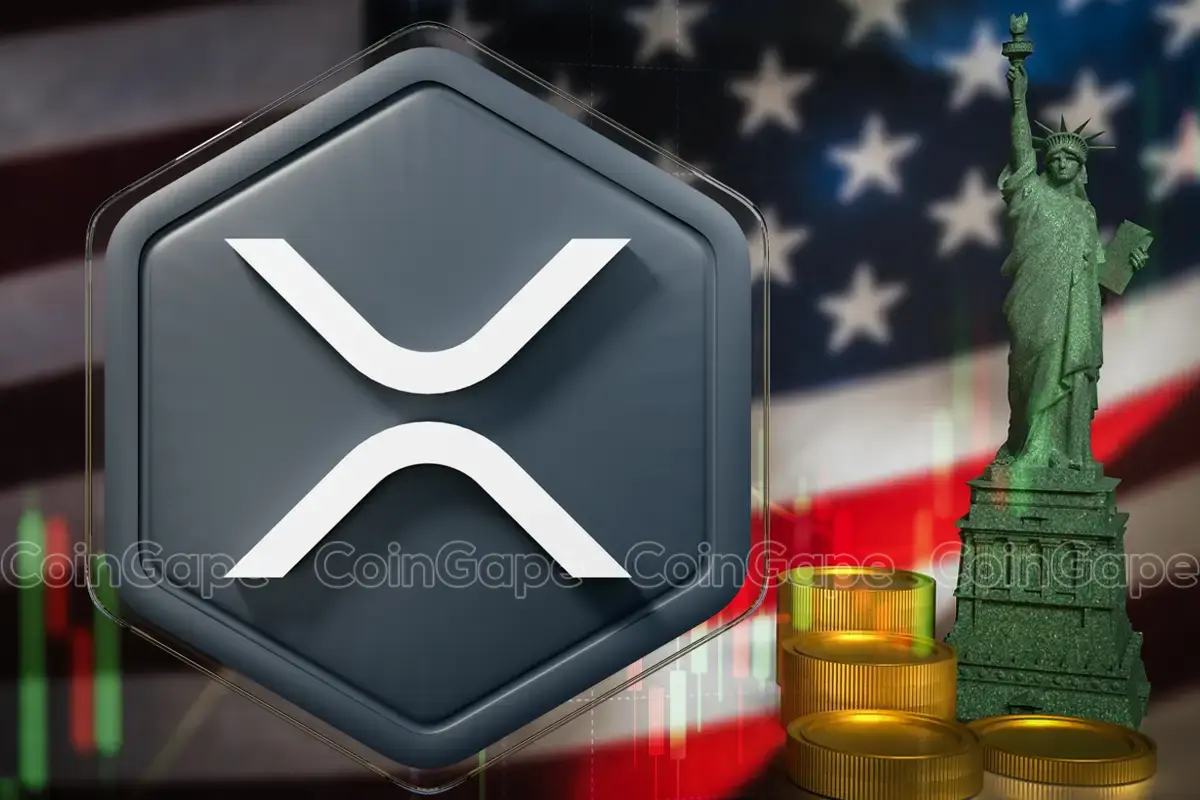Market
This Is How DePIN Can Solve AI’s Global Energy Crisis

The rise of artificial intelligence (AI) and generative AI technologies has been meteoric in the past two years. For some tech-savvy people, every morning begins with the help of AI, from the smart alarm that tracks their sleep cycle to the news app that curates articles based on their interests.
But behind these seamless conveniences lies a hidden reality – these technologies are part of a growing energy crisis. As AI technologies like generative AI advance, they are not just transforming our lives; they’re demanding a huge share of the world’s electricity.
Impact of AI on Energy Infrastructures
The challenge is stark. As one of the most energy-intensive modern IT endeavors, AI systems require considerable carbon emissions and electricity. Indeed, the world might not be ready for their demands.
In 2023, the world became acquainted with the implications of generative AI, and by 2024, its utilization in various sectors magnified. Hence, data centers that power these AI models are becoming massive consumers of electricity.
Indeed, Forbes noted that GPT-4 required over 50 gigawatt-hours to train—equivalent to 0.02% of California’s annual electricity production. Moreover, it requires 50 times more energy than its predecessor, GPT-3.
The statistics are staggering. Globally, data centers and their transmission networks now contribute to 3% of global energy consumption, emitting as much carbon dioxide as Brazil.
Moreover, the escalating energy requirements show no signs of abating. According to an International Energy Agency (IEA) projection, global electricity demand will surge from 460 terawatt-hours (TWh) in 2022 to 1000 TWh by 2026.
Read more: How To Build Your Personal AI Chatbot Using the ChatGPT API

In the United States alone, the power demand from data centers is expected to increase from 200 TWh in 2022 to 260 TWh by 2026, marking a 6% share of the country’s total power usage. Projections suggest this demand will double by 2030.
Amid this backdrop, Ayush Ranjan, CEO of Huddle01, highlighted in an interview with BeInCrypto the urgent need for solutions like DePIN (Decentralized Physical Infrastructure Network).
“AI data centers require a substantial amount of electricity for computation and cooling. If AI applications continue to grow at the current rate, we will see a significant strain on both local and global energy grids that will prove unsustainable. This burden will continue to increase as AI systems get more and more complex with time. This will again lead to higher emissions and grid instability,” Ranjan explained.
The geographic clustering of data centers compounds the challenges. For instance, Northern Virginia hosts the largest hub of data centers globally, consuming electricity equivalent to that of 800,000 homes. This concentration creates dangerous fluctuations in power demand, posing severe risks to energy infrastructures.
How DePIN Solves the Challenges
In response, DePIN offers a promising solution by leveraging underutilized hardware resources to distribute computational tasks more efficiently. By decentralizing energy consumption and incentivizing the use of edge computing, DePIN networks could significantly alleviate the energy burden imposed by AI, offering a pathway to more sustainable and democratized access to AI resources.
Ranjan further elucidated that DePINs distribute energy consumption and workload, easing the burden on any single point. Instead of relying on huge centralized data centers, DePIN deploys multiple nodes—often utilizing underused infrastructure to offload computations closer to end-users.
“This reduces the workload on servers and spreads energy consumption more evenly across regions, easing the burden on energy grids,” Ranjan told BeInCrypto.
Currently, 84% of the data centers are concentrated around the United States, Europe, and China, making data transfers less energy efficient. However, edge computing, integral to DePIN, minimizes long-distance, energy-intensive data transfers typical of centralized data centers.
“Splitting the energy consumption across multiple devices and regions, reducing the load on data centers and energy grids by leveraging existing devices or resources to build the network will prove critical in solving this issue,” Ranjan affirmed.
Read more: What Is DePIN (Decentralized Physical Infrastructure Networks)?
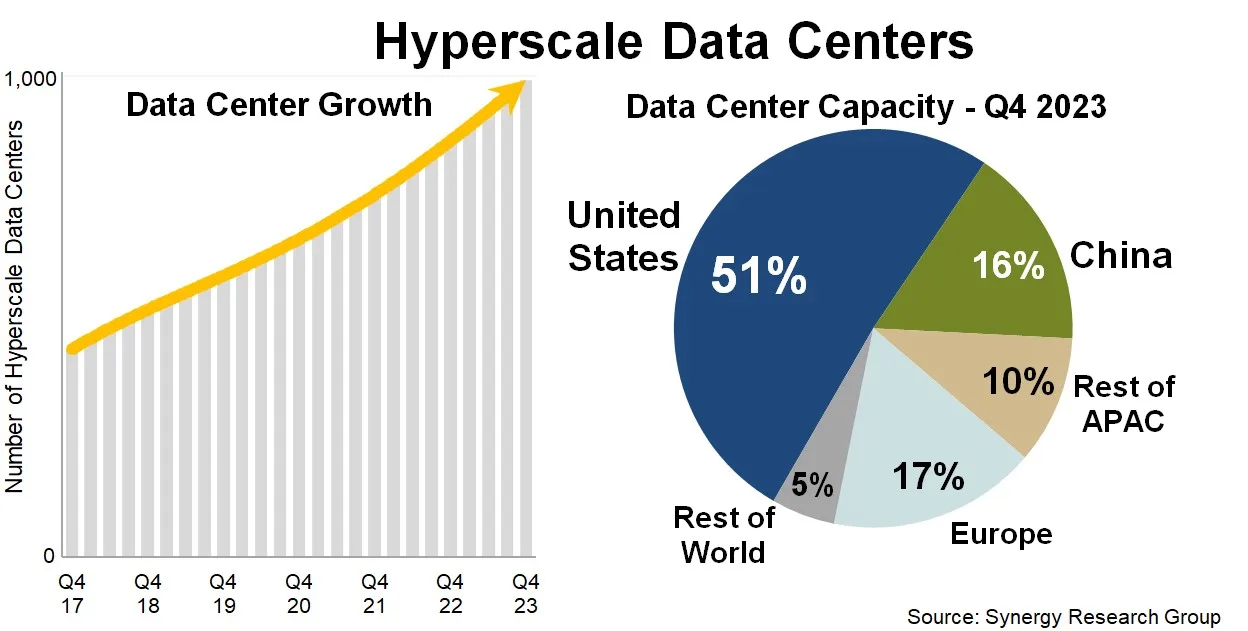
DePin Projects Addressing AI’s Demands
According to Ranjan, several DePIN projects, like Filecoin Green, Akash Network, Render, and Grass, focus on addressing AI’s energy demands.
Notably, the Daylight Energy project, backed by prominent venture capitalist firm Andreessen Horowitz (a16z), aims to transform energy grid operations through distributed energy resources (DERs). This initiative enhances grid responsiveness and facilitates sustainable energy practices by leveraging real-time data from DERs such as solar panels and smart batteries.
Moreover, on September 10, Daylight Energy announced a partnership with DIMO Network to enable electric vehicles (EVs) to support power grids. This collaboration utilizes DIMO’s EV application programming interfaces (APIs) to integrate EVs into the energy management ecosystem, thereby facilitating clean energy usage and real-time energy management for all EV owners.
DePIN networks also solve other challenges of centralized infrastructure, such as frequent outages. For instance, a recent IT outage involving Microsoft and CrowdStrike disrupted major services worldwide. However, DePIN networks are less susceptible to such outages because they do not have a single point of failure.
Currently, the total market capitalization of DePIN projects stands above $20.5 billion. Additionally, the total number of DePIN devices has crossed 18 million. However, DePIN still faces scalability challenges as the mainstream adoption of these networks requires high computational power.
“Many DePINs rely on a mix of devices, from low-powered edge devices to small-scale data centers. Scaling the network and coordinating the deployed resources to match the computational power of a centralized data center remains a formidable industry challenge,” Ranjan noted.
Read more: Top 10 Web3 Projects That Are Revolutionizing the Industry

However, while the idea of DePIN rescuing the world from a global energy crisis remains nascent, further innovation and adoption are essential. Ranjan believes that token incentives can help bring more adoption.
“Because of hardware limitations of edge devices to handle AI workload, wide adoption is crucial for any DePIN to scale and see a mainstream use case. Token incentives help drive intent to use and participate,” Ranjan concluded.
Disclaimer
Following the Trust Project guidelines, this feature article presents opinions and perspectives from industry experts or individuals. BeInCrypto is dedicated to transparent reporting, but the views expressed in this article do not necessarily reflect those of BeInCrypto or its staff. Readers should verify information independently and consult with a professional before making decisions based on this content. Please note that our Terms and Conditions, Privacy Policy, and Disclaimers have been updated.
Market
Bitcoin & Ethereum Options Expiry: Can Prices Stay Stable?

The crypto market is set to see $2.58 billion in Bitcoin and Ethereum options expire today, a development that could trigger short-term price volatility and impact traders’ profitability.
Of this total, Bitcoin (BTC) options account for $2.18 billion, while Ethereum (ETH) options represent $396.16 million.
Bitcoin and Ethereum Holders Brace For Volatility
According to data on Deribit, 26,457 Bitcoin options will expire today, significantly lower than the first quarter (Q1) closer, where 139,260 BTC contracts went bust last week. The options contracts due for expiry today have a put-to-call ratio 1.25 and a maximum pain point of $84,000.
The put-to-call ratio indicates a higher volume of puts (sales) relative to calls (purchases), indicating a bearish sentiment. More traders or investors are betting on or protecting against a potential market drop.
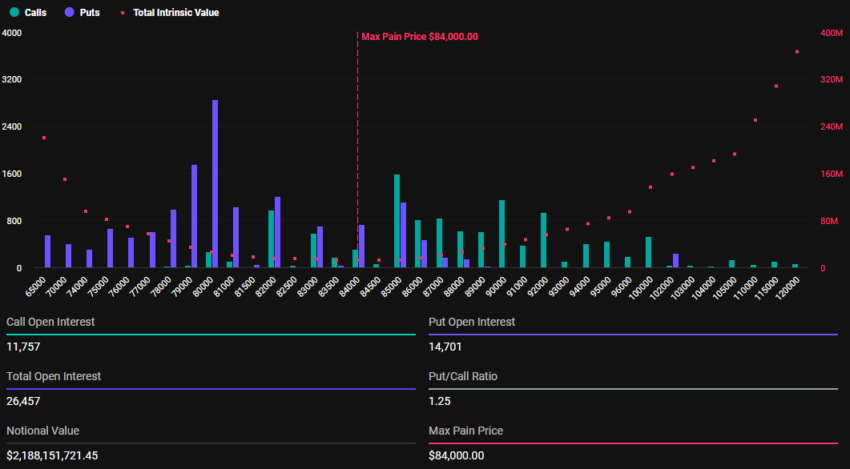
On the other hand, 221,303 Ethereum options will also expire today, down from 1,068,519 on the last Friday of March. With a put-to-call ratio of 1.41 and a max pain point of $1,850, the expirations could influence ETH’s short-term price movement.
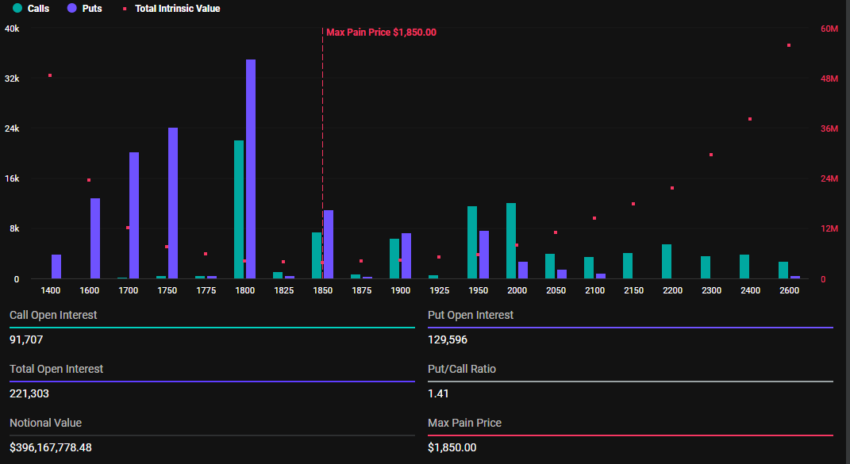
As the options contracts near expiration at 8:00 UTC today, Bitcoin and Ethereum prices are expected to approach their respective maximum pain points. According to BeInCrypto data, BTC was trading at $82,895 as of this writing, whereas ETH was exchanging hands for $1,790.
This suggests that prices might rise as smart money aims to move them toward the “max pain” level. Based on the Max Pain theory, options prices tend to gravitate toward strike prices where the highest number of contracts, both calls and puts, expire worthless.
Nevertheless, price pressure on BTC and ETH will likely ease after 08:00 UTC on Friday when Deribit settles the contracts. However, the sheer scale of these expirations could still fuel heightened volatility in the crypto markets.
“Where do you see the market going next? Deribit posed.
Elsewhere, analysts at Greeks.live explain the current market sentiment, highlighting a bearish outlook. This adds credence to why more traders are betting on or protecting against a potential market drop.
Bearish Sentiment Grips Markets
In a post on X (Twitter), Greeks.live reported a predominantly bearish sentiment in the options market. This follows US President Donald Trump’s tariff announcement.
BeInCrypto reported that the new tariffs constituted a 10% blanket rate and 25% on autos. While this fell short of market expectations, it was still perceived as a negative development, sparking widespread concern among traders.
According to the analysts, options flow reflected this pessimism, with heavy put buying dominating trades.
“Trump’s tariffs are viewed as severe trade disruption… The market’s initial positive reaction with a price spike to $88 was seen as gambling/short covering, followed by a sharp reversal as reality set in about economic impacts. Options flow remains heavily bearish, with traders noting significant put buying, including “700 79k puts for end of April,” wrote Greeks.live analysts.
Traders snapping up 700 $79,000 puts for the end of April signals expectations of a sustained downturn. According to the analysts, the consensus among traders points to continued volatility, with a potential “bad close” below $83,000 today, Friday, April 4. Such an action would erase the earlier pump entirely.
Meanwhile, many traders are adopting bearish strategies, favoring short calls or put calendars. Shorting calls is reportedly deemed the most effective approach in the current climate.
Therefore, while the market’s initial reaction to Trump’s tariffs was a mix of hope and reality, the reversal reflects the broader economic fallout from Trump’s policies. As traders brace for choppy conditions, the bearish outlook in options trading paints a cautious picture for the days ahead.
Global supply chain disruptions and economic uncertainty remain at the forefront of market concerns.
Disclaimer
In adherence to the Trust Project guidelines, BeInCrypto is committed to unbiased, transparent reporting. This news article aims to provide accurate, timely information. However, readers are advised to verify facts independently and consult with a professional before making any decisions based on this content. Please note that our Terms and Conditions, Privacy Policy, and Disclaimers have been updated.
Market
XRP Battle Heats Up—Can Bulls Turn the Tide?

XRP price started a fresh decline below the $2.050 zone. The price is now consolidating and might face hurdles near the $2.10 level.
- XRP price started a fresh decline below the $2.120 and $2.050 levels.
- The price is now trading below $2.10 and the 100-hourly Simple Moving Average.
- There is a short-term declining channel forming with resistance at $2.0680 on the hourly chart of the XRP/USD pair (data source from Kraken).
- The pair might extend losses if it fails to clear the $2.10 resistance zone.
XRP Price Attempts Recovery
XRP price extended losses below the $2.050 support level, like Bitcoin and Ethereum. The price declined below the $2.00 and $1.980 support levels. A low was formed at $1.960 and the price is attempting a recovery wave.
There was a move above the $2.00 and $2.020 levels. The price surpassed the 23.6% Fib retracement level of the downward move from the $2.235 swing high to the $1.960 low. However, the bears are active below the $2.10 resistance zone.
The price is now trading below $2.10 and the 100-hourly Simple Moving Average. On the upside, the price might face resistance near the $2.070 level. There is also a short-term declining channel forming with resistance at $2.0680 on the hourly chart of the XRP/USD pair.
The first major resistance is near the $2.10 level. It is near the 50% Fib retracement level of the downward move from the $2.235 swing high to the $1.960 low. The next resistance is $2.120.
A clear move above the $2.120 resistance might send the price toward the $2.180 resistance. Any more gains might send the price toward the $2.2350 resistance or even $2.40 in the near term. The next major hurdle for the bulls might be $2.50.
Another Decline?
If XRP fails to clear the $2.10 resistance zone, it could start another decline. Initial support on the downside is near the $2.00 level. The next major support is near the $1.960 level.
If there is a downside break and a close below the $1.960 level, the price might continue to decline toward the $1.920 support. The next major support sits near the $1.90 zone.
Technical Indicators
Hourly MACD – The MACD for XRP/USD is now losing pace in the bearish zone.
Hourly RSI (Relative Strength Index) – The RSI for XRP/USD is now above the 50 level.
Major Support Levels – $2.00 and $1.960.
Major Resistance Levels – $2.10 and $2.120.
Market
Ethereum Price Losing Ground—Is a Drop to $1,550 Inevitable?

Reason to trust

Strict editorial policy that focuses on accuracy, relevance, and impartiality
Created by industry experts and meticulously reviewed
The highest standards in reporting and publishing
Strict editorial policy that focuses on accuracy, relevance, and impartiality
Morbi pretium leo et nisl aliquam mollis. Quisque arcu lorem, ultricies quis pellentesque nec, ullamcorper eu odio.
Ethereum price attempted a recovery wave above the $1,820 level but failed. ETH is now consolidating losses and might face resistance near the $1,840 zone.
- Ethereum failed to stay above the $1,850 and $1,840 levels.
- The price is trading below $1,840 and the 100-hourly Simple Moving Average.
- There is a short-term bearish trend line forming with resistance at $1,810 on the hourly chart of ETH/USD (data feed via Kraken).
- The pair must clear the $1,820 and $1,840 resistance levels to start a decent increase.
Ethereum Price Dips Further
Ethereum price failed to stay above the $1,800 support zone and extended losses, like Bitcoin. ETH traded as low as $1,751 and recently corrected some gains. There was a move above the $1,780 and $1,800 resistance levels.
The bulls even pushed the price above the 23.6% Fib retracement level of the downward move from the $1,955 swing high to the $1,751 low. However, the bears are active near the $1,820 zone. The price is now consolidating and facing many hurdles.
Ethereum price is now trading below $1,820 and the 100-hourly Simple Moving Average. On the upside, the price seems to be facing hurdles near the $1,810 level. There is also a short-term bearish trend line forming with resistance at $1,810 on the hourly chart of ETH/USD.
The next key resistance is near the $1,840 level or the 50% Fib retracement level of the downward move from the $1,955 swing high to the $1,751 low at $1,850. The first major resistance is near the $1,880 level.
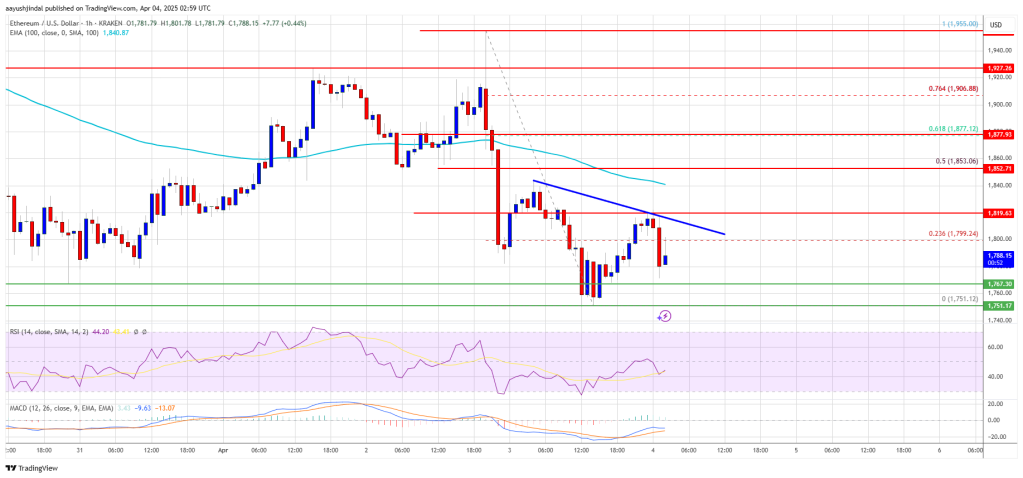
A clear move above the $1,880 resistance might send the price toward the $1,920 resistance. An upside break above the $1,920 resistance might call for more gains in the coming sessions. In the stated case, Ether could rise toward the $2,000 resistance zone or even $2,050 in the near term.
Another Decline In ETH?
If Ethereum fails to clear the $1,850 resistance, it could start another decline. Initial support on the downside is near the $1,765 level. The first major support sits near the $1,750 zone.
A clear move below the $1,750 support might push the price toward the $1,720 support. Any more losses might send the price toward the $1,680 support level in the near term. The next key support sits at $1,620.
Technical Indicators
Hourly MACD – The MACD for ETH/USD is gaining momentum in the bearish zone.
Hourly RSI – The RSI for ETH/USD is now below the 50 zone.
Major Support Level – $1,750
Major Resistance Level – $1,850
-

 Market20 hours ago
Market20 hours agoIP Token Price Surges, but Weak Demand Hints at Reversal
-

 Market23 hours ago
Market23 hours agoEthereum Price Recovery Stalls—Bears Keep Price Below $2K
-

 Altcoin21 hours ago
Altcoin21 hours agoBinance Issues Key Announcement On StakeStone TGE; Here’s All
-

 Altcoin20 hours ago
Altcoin20 hours agoMovimiento millonario de Solana, SOLX es la mejor opción
-

 Ethereum20 hours ago
Ethereum20 hours agoEthereum Trading In ‘No Man’s Land’, Breakout A ‘Matter Of Time’?
-

 Bitcoin20 hours ago
Bitcoin20 hours agoBlackRock Approved by FCA to Operate as UK Crypto Asset Firm
-

 Altcoin19 hours ago
Altcoin19 hours agoJohn Squire Says XRP Could Spark A Wave of Early Retirements
-
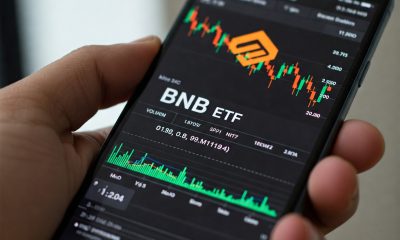
 Altcoin22 hours ago
Altcoin22 hours agoVanEck Seeks BNB ETF Approval—Big Win For Binance?






